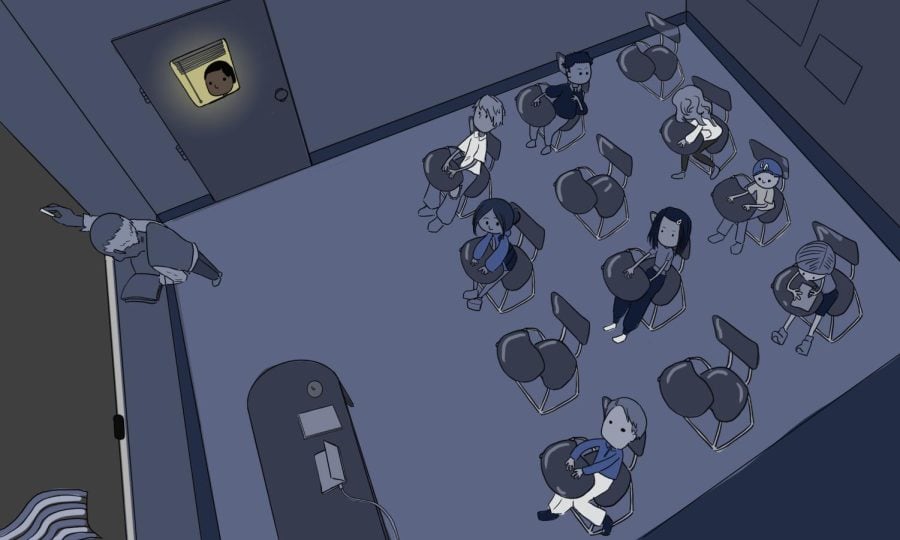ETHS disproportionately suspends Black students. That trend isn’t changing.
In the 2021-2022 school year, 67.8% of out-of-school suspensions at ETHS involved Black or African American students, while only 24.8% of students overall were Black or African American.
February 13, 2023
When students enter Evanston Township High School, a sign reading “All Are Welcome Here” greets them in more than 25 languages.
However, some students say they’ve been less welcomed than others when walking through the halls.
“Personally, I see more students of color being called out and being told, ‘Where’s your pass?’ or ‘Where are you going?’ by safety officers in our school more often than white people are being called out,” said ETHS senior Amira Grace.
That observation is backed by Illinois State Board of Education disciplinary data on expulsions, suspensions and truancy. According to records from the past 10 years, Black students have consistently faced disciplinary actions at higher rates than white students. The ETHS director of communications did not respond to requests for comment on demographic trends in disciplinary actions.
During the 2021-2022 academic year, 24.8% of ETHS students were Black or African American and 45.1% of ETHS students were white, according to ISBE data.
During that academic year, 45.6% of students disciplined with an in-school suspension and 67.8% of students disciplined with an out-of-school suspension were Black or African American. White students made up just 18.9% of students disciplined with an in-school suspension and 8% of students with an out-of-school suspension.
Grace said she’s often heard students talking about the differences in how students of color are treated compared to white students. Sometimes, she said bias seemed “extreme” and punishments against students of color struck her as “extreme and unwarranted.”
“The administration says a lot of things, like ‘We want to make this change,’ but it doesn’t ever happen,” Grace said. “I haven’t seen any policies or activism … when it’s in regards to implicit racism and implicit bias.”
The disproportionate suspension rates have remained consistent over the past decade. In the 2013-2014 academic year, 73.3% of incidents resulting in out-of-school suspensions involved Black or African American students, while 4.9% of incidents involved white students.
Shelley Gates, a former ETHS teacher and department chair, suggested the disparity is rooted in racially biased perception of students’ behavior.
“Adults, whether they’re conscious of it or not, may perceive actions by students of color differently than they would perceive those actions by white kids,” Gates said. “A white kid might do something that was probably against the rules, and then they get a pass for it. And then a student of color does the same thing, and is sent to the dean’s office.”
The disparity may be explained by the combination of systemic racism, people’s stereotyping of certain behaviors and the complexity of teenagers, according to Gates.
In an email statement to The Daily, Luca Guacci, managing attorney of the Education Advocacy Program at the Moran Center, said systemic racism is embedded in the school’s suspensions.
“The disciplinary policies active at ETHS … unwittingly serve to undergird the historically racist and intentional disinvestment in, and the punitive policing of children from Black and Brown communities, resulting in the exclusion of Black and Brown students from opportunities toward economic mobility, civic engagement, conflict resolution, and justice,” they wrote.
The damage incurred by such practices comes with no effectiveness, according to Christina LiCalsi (SESP ’11,’14), a principal researcher at the American Institutes for Research.
In a 2021 study, LiCalsi and her research team found that exclusionary practices fail to reduce future misbehavior of the disciplined students or their peers.
“All you’re doing really is weakening the bond that they have with the school environment, weakening the trust that they have in the school and the adults, which is linked to poor outcomes moving forward,” LiCalsi said. “I think restorative practices is really one of the most important alternatives, and I think that trauma-informed care within schools is critical.”
Grace, who is a member of the ETHS Student Union, said she feels administration has shown “apathy” when communicating with her and her peers instead of building trust. She said students have told her they feel “demeaned,” “condescended to” and “emotionally hurt” after speaking with administrators.
To improve the disproportionate targeting of students of color, Grace said administration should start by being attentive to students’ perspectives and increasing student involvement in creating school policy.
“Even though a lot of people want to dismiss anecdotes, anecdotes can be really powerful,” Grace said. “I think it starts off with listening to students — not only listening to them, but collaborating with them.”
Email: [email protected]
Email: [email protected]
Twitter: @sonyawanders
Related Stories:
— ETHS staff say the school teaches about reparations. Some students say they haven’t learned enough
— District 202 Board of Education discusses equity of AP enrollment, access
— Some ETHS students notice dip in antiracist activism, but continue to fight


